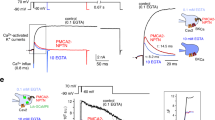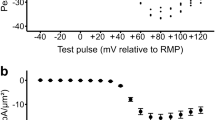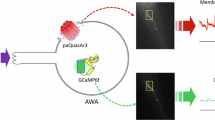Abstract
GENERATION of Na and Ca spikes in various types of vertebrate nerve cells1–6 indicates that both Na and Ca channels are generally involved in inducing action potentials in their cell bodies. Although it has been suggested that these ionic channels may change their configuration in the plasma membrane, in particular during degeneration of nerve cells7,8 or during growth of axons associated with ontogenetic differentiation9–11, no systematic or quantitative study has been reported. We have recently established a technique to obtain primary culture of nerve cells of mature mammals12,13, and have also developed a technique to compare membrane capability of carrying inward Na and Ca currents among nerve cells of various ages in the cell culture. We report here that the capability of membranes to carry Ca currents, as represented by the maximum rate of rise (MRR) of a Ca spike, is enhanced during a particular period of the cell culture, whereas there is no significant change in Na currents. This may be explained as an increase in number of the Ca channels or as a change in conformation of the Ca channels, associated, in part, with neurite outgrowth. As we used nerve cells which had fully differentiated in the host bodies, the possibility of an effect due to ontogenetic differentiation in the tissue culture condition14–19 can be excluded. The present finding also demonstrates another aspect of nerve cell membrane that ionic channel molecules, especially the Ca channels, can alter their features rather flexibly in the plasma membrane.
This is a preview of subscription content, access via your institution
Access options
Subscribe to this journal
Receive 51 print issues and online access
$199.00 per year
only $3.90 per issue
Buy this article
- Purchase on SpringerLink
- Instant access to full article PDF
Prices may be subject to local taxes which are calculated during checkout
Similar content being viewed by others
References
Barrett, E. F. & Barrett, J. N. J. Physiol., Lond. 255, 737–774 (1976).
Koketsu, K. & Nishi, S. J. gen. Physiol. 53, 608–623 (1969).
Krnjevic, K. & Lesiewicz, A. J. Physiol., Lond. 225, 363–390 (1972).
Llinas, R. & Hess, R. Proc. natn. Acad. Sci. U.S.A. 73, 2520–2523 (1976).
Schwartzkroin, P. A. & Slawsky, M. Brain Res. 135, 157–161 (1977).
Spitzer, N. C. & Baccaglini, P. I. Brain Res. 107, 610–616 (1976).
Eccles, J. C., Libet, B. & Young, R. R. J. Physiol., Lond. 143, 11–40 (1958).
Kuno, M., Miyata, Y. & Munoz-Martinez, E. J. J. Physiol., Lond. 240, 725–739 (1974).
Spitzer, N. C. & Lamborghini, J. E. Proc. natn. Acad. Sci. U.S.A. 73, 1641–1645 (1976).
Matsuda, Y., Yoshida, S. & Yonezawa, T. Brain Res. 115, 334–338 (1976); 54, 69–82 (1978).
Ranson, B. R. & Holz, R. W. Brain Res. 136, 445–453 (1977).
Fukuda, J. & Kameyama, M. Neuroscience, Suppl. 6, IBRO News, 2 (1978).
Fukuda, J. & Kameyama, M. VI Int. Biophys. Congr. Abstr., 150 (1978).
Nakai, J. Am. J. Anat. 99, 81–130 (1956).
Crain, S. M. J. comp. Neurol. 104, 285–330 (1956).
Scott, B. S., Engelbert, V. E. & Fisher, K. C. Expl Neurol. 23, 230–248 (1969).
Okun, L. M. J. Neurobiol. 3, 111–151 (1972).
Mains, R. E. & Patterson, P. H. J. Cell Biol. 59, 329–345 (1973).
Ranson, B. R., Neale, E., Henkart, P., Bullock, P. W. & Nelson, P. G. J. Neurophysiol. 40, 1132–1150 (1977).
Jack, J. J. B., Noble, D. & Tsien, R. W. Electric Current Flow in Excitable Cells (Clarendon, Oxford, 1971).
Hagiwara, S., Hayashi, H. & Takahashi, K. J. Physiol., Lond. 205, 115–129 (1969).
Standen, N. B. J. Physiol., Lond. 249, 253–268 (1975).
Trautwein, W. Physiol. Rev. 54, 793–835 (1973).
Neher, E. & Lux, H. D. Pflügers Arch. 336, 87–100 (1972).
Narahashi, T. Physiol. Rev. 54, 813–889 (1974).
Hagiwara, S. Adv. Biophys. 4, 71–102 (1973).
Dipolo, R. et al. J. gen. Physiol. 67, 433–467 (1976).
Thomas, M. V. & Gorman, A. L. F. Science 29, 531–533 (1977).
Katz, B. The Release of Neural Transmitter Substances (University Press, Liverpool, 1969).
Hammerschlag, R., Bahkit, C., Chiu, A. Y. & Dravid, A. R. J. Neurobiol. 8, 439–451 (1977).
Hammerschlag, R., Dravid, A. R. & Chiu, A. Y. Science 188, 273–275 (1975).
Lux, H. D., Schubert, P., Kreutzberg, G. W. & Globus, A. Expl Brain Res. 10, 197–204 (1970).
Author information
Authors and Affiliations
Rights and permissions
About this article
Cite this article
FUKUDA, J., KAMEYAMA, M. Enhancement of Ca spikes in nerve cells of adult mammals during neurite growth in tissue culture. Nature 279, 546–548 (1979). https://doi.org/10.1038/279546a0
Received:
Accepted:
Published:
Issue date:
DOI: https://doi.org/10.1038/279546a0
This article is cited by
-
Scanning electron-microscope observations of the perikaryal projections of rabbit spinal ganglion neurons after enzymatic removal of connective tissue and satellite cells
Cell and Tissue Research (1990)
-
Ionic currents in cultured dorsal root ganglion cells from adult guinea pigs
The Journal of Membrane Biology (1983)
-
Breakdown of cytoskeletal filaments selectively reduces Na and Ca spikes in cultured mammal neurones
Nature (1981)
-
Spike potentials and membrane properties of dorsal root ganglion cells in pigeons
Pfl�gers Archiv European Journal of Physiology (1980)



